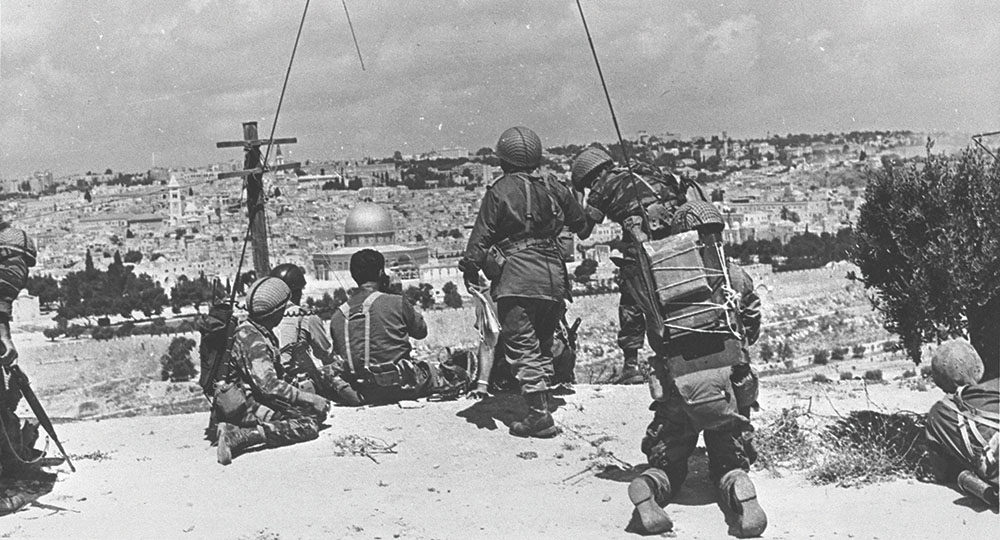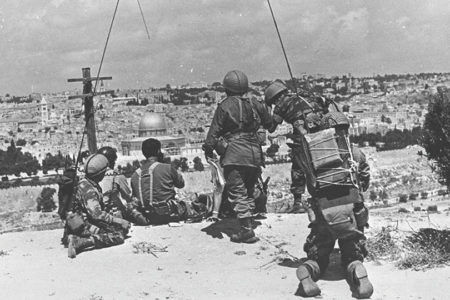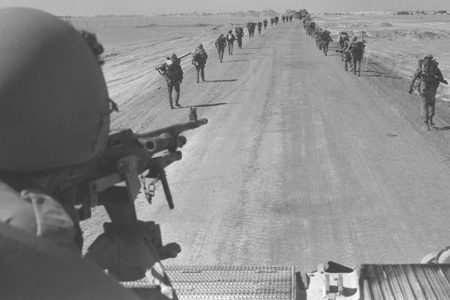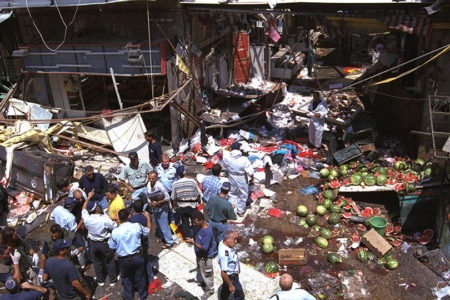Six Days In June Oct/Nov 1997
“A people considered for centuries as non-fighters carried out in June, 1967 against long odds the most nearly perfect military operation in modern history.” With these words an eminent American historian opened her brilliant essay on Israel’s stunning victory in the Six–Day War of June 1967 (Barbara Tuchman, “Israel’s Swift Sword,” in Practicing History, 1981, pp. 173–187).
Historians, commentators, and statesmen alike have expressed amazement at Israel’s dramatic victory more than 30 years ago. In six brief and dizzying days, a small but determined civilian army beat incalculable odds and altered the future course of Middle Eastern history. At the same time they gained new respect for a people long thought doomed to humiliating exile among the nations. The tiny nation of Israel, composed at that time of only two and a half million citizens, within a week found itself in control of an area twice its previous size. The suddenness and significance of Israel’s victory raise the inevitable questions, “Why?” and “How?” While secularists may offer their answers, the uniqueness of this brief war forces believers to suggest a possible divine explanation.
Gamal Abdul Nasser, the autocratic President of Egypt, had never lost his hope of someday being the “savior” of the Arab world. The Arab countries’ defeat in 1948 remained an open disgrace that had to be avenged. The predominantly Moslem Arab states simply could not conceive of the idea that the Jews, destined to humiliation in their Koran, could actually possess a sovereign state in the midst of the so-called “World of Islam.”
Israel’s victory over Egypt in the Sinai Campaign of 1956 had only added salt to the festering wound in Arab pride. The Arab nations, outnumbering the Israelis more than 50 to 1, could not tolerate the disgrace any longer. During the spring of 1967, the anti-Israel tirades increased in rallies and radio addresses throughout the Middle East. No leader was more inflamed in his rhetoric than Nasser. His threats turned to actions on May 15 when he ordered the United Nations peacekeeping troops out of the Sinai Peninsula. It was becoming evident what was about to take place.
Soon after the UN departure, Nasser ordered a blockade of the Strait of Tiran with these ominous words, “The Strait of Tiran is part of our territorial waters. No Israeli ship will ever navigate it again.” This blockade cut off Israel’s southern access to the Red Sea and beyond.
It was, by any possible definition, an “act of war.” We wonder how the United States would respond if Canada suddenly blockaded the Saint Lawrence Seaway to all United States shipping!
Nasser and other Arab leaders continued their drum-beating. Consider the following quotation, an example of many that could be cited. “The existence of Israel is an error which must be rectified. This is our opportunity to wipe out the ignominy, which has been with us since 1948. Our goal is clear—to wipe Israel off the map” (President Aref of Iraq, May 31, 1967).
By May 31, Egypt had moved 100,000 troops, 1,000 tanks, and 500 heavy guns into the Sinai. By June 4, Israel was outnumbered by Arab forces three to one on its borders. In light of these pressures, who would be surprised if Israel finally decided to defend itself?
Israel’s Six–Day War was fought on three fronts against three countries in three overlapping stages. In the south, Israel engaged and defeated the Egyptians. In the central region, Israel engaged and defeated the Jordanians. In the north, Israel engaged and defeated the Syrians. In each of these theaters, Israel gained significant territory that would serve as its own buffers in future years. (Consult closely the accompanying map for clarification. The map, as well as the above quotation, are taken from Atlas of the Arab-Israeli Conflict, by Martin Gilbert, pp. 67–68.)
Securing The Sinai
On the morning of June 5, the Israeli Air Force destroyed almost the entire Egyptian Air Force (more than 300 planes) in less than three hours. The amazing fact about this meticulously planned and executed operation is that most of those aircraft were destroyed on the ground before they could ever take off! Knowledgeable Israelis have said that, even though the war lasted a scant six days, it was really over in just three hours. With no air cover, the Egyptian infantry efforts were doomed.
Israel’s armored divisions, under the leadership of Ariel Sharon, also launched a lightning attack on the same day. Sharon’s experience under his tutor, Moshe Dayan, in the 1956 Sinai Campaign served him well in this desert warfare. The tanks and other heavy armor rolled over the Egyptian defenses, first in the Gaza Strip and then in the desert wastes and through the narrow passes of the peninsula. By the evening of June 7, Israel’s troops were secure on the eastern bank of the Suez Canal. Behind them lay the smoldering hulks of the out-manned and out-maneuvered Egyptian armored units. More than 800 Egyptian tanks had been destroyed, and thousands of soldiers were taken as prisoners of war. Nasser later acknowledged that 80 percent of Egypt’s Russian-supplied military equipment had been lost in the Sinai debacle. It was a horrible humiliation, not only for Nasser, but also for Nasser’s military patron, the Soviet Union.
While Sharon’s divisions were driving westward, Israeli paratroopers captured the Egyptian position at Sharm el Sheik at the southern tip of the Sinai, which led to the break up of the naval blockade of the Strait of Tiran. Finally, at 8:00 p.m. on June 8, Nasser accepted a cease-fire. If he had not done so, the Israeli army was more than ready to cross the canal and head toward Cairo. The first act of this rapidly developing drama was ended.
Joining the Jerusalems
An explanation of the strange title used for this second phase of the war is needed. From 1948 to 1967, Jerusalem was a divided city. East Jerusalem, including the Old City, had been occupied by the Arab Legion of Jordan since the War of Independence. The Jordanian troops had decimated the Jewish Quarter of the Old City, blowing up its synagogues and destroying every vestige of Jewish life there. Jewish gravestones on the Mount of Olives had been used to pave roads and build latrines. Although promising access to the Western Wall, Jordan had not allowed any Jews to pray at this remnant of the wall that had once surrounded the ancient Temple. Western Jerusalem, on the other hand, was controlled by Israel and had greatly expanded during this period. Barbed wire, minefields, and concrete walls protecting Jews from Jordanian snipers cut through the heart of Jerusalem from north to south. The Six–Day War would end all of that and unite the Holy City once again.
A strange irony of this conflict is that Israel did not plan to retake the city, much less the remainder of the area captured from Jordan. During the initial battles with Egypt, Israel actually notified King Hussein that it had no intention of attacking his country. Hussein, however, believed the lies Nasser was telling about his success against the Israelis in the Sinai and bowed to his pressure to join in the great Arab “victory.” When the Arab Legion began to shell Western Jerusalem, the Israelis swiftly counterattacked, with utterly astounding success.
The many individual battles in and around the Old City are too numerous to mention. The Israeli infantry fought past strong Arab positions at Ammunition Hill and the Rockefeller Museum to break into the Old City from the north. Mordecai Gur’s paratroopers landed and attacked from the Mount of Olives, entering the Lion Gate from the east. Israel was careful to minimize the use of artillery, which could have made their attack much easier with less loss of life. This was done out of respect for the numerous holy sites within the ancient walls. By June 8, Israeli troops were gazing at the Herodian stones of the Western Wall, wondering if they should dance, pray, or cry. They did all three!
Although Jerusalem was the central prize, Israel also captured in those four fierce days the areas of biblical Judea and Samaria. Now not only the site of biblical Jerusalem, but also the ancient towns of Shechem, Shiloh, Bethel, Bethlehem, and Hebron were again in Jewish hands.
Gaining The Golan
Egypt’s ally in the north was Syria. From their heavily fortified bunkers and miles of trenches along the Golan Heights, Syrian gunners had harassed the Jewish farmers and fishermen of the Huleh Valley and Sea of Galilee for 19 years. The problem for the Israelis was that the Syrians literally held the high ground, and their Russian sponsors had helped them to fortify it well. With Syria also threatening Israel’s destruction, the army saw an opportunity to end this threat to its northern citizens once and for all.
The battle for the Golan was difficult. This was not a desert, like the Sinai, where tanks could maneuver easily. Furthermore, the Syrians had planted millions of mines to deter any Israeli response to its constant shelling. The Air Force prepared the way by landing paratroopers behind the Syrian lines. One unit of paratroopers actually fought on all three fronts of the war in the space of six days! Finally, Israeli bulldozers were able to clear the way so the armored units could batter the Syrian troops and drive them deep into the Golan. Syria accepted a cease-fire on June 10. In succeeding years, where the Syrians had planted mines, Israeli farmers planted fruit trees.
Although it was an amazing military victory, the Six–Day War left more than 700 Israelis dead and more than 2,500 wounded. Although figures were never officially released, Arab casualties were conservatively estimated at 15,000. Golda Meir expressed the feelings of Israelis well when she remarked, “We can forgive the Arabs for killing our sons. We can’t forgive them, however, for forcing us to kill their sons.”
The Six–Day War established Israel as a major military power, but it unexpectedly cast it in the role of “occupier”—a burden that has proven hard to bear for 30 years. Israel eventually returned the Sinai to Egypt (after another war in 1973), when President Sadat finally acknowledged their legitimate existence. Israel remains in control of the Golan Heights, unwilling to see it return to a nest of bunkers and artillery positions. On the other hand, Israel is under great pressure to return most of the West Bank—those areas of biblical Judea and Samaria. Israel does not trust the PLO to oversee such a “Palestinian State” in light of its murderous record of terrorism.
There is one result of the Six–Day War that, hopefully, will never change—a united Jerusalem. That city is the heart and soul of the Jewish people. Its development over the years—culturally, socially, archaeologically—is marvelous to behold. It is probably the one legacy of that brief conflict that will never be forfeited by Israel. Let us hope and pray that it will always be under the control of those descendants of David to whom it means so much.







